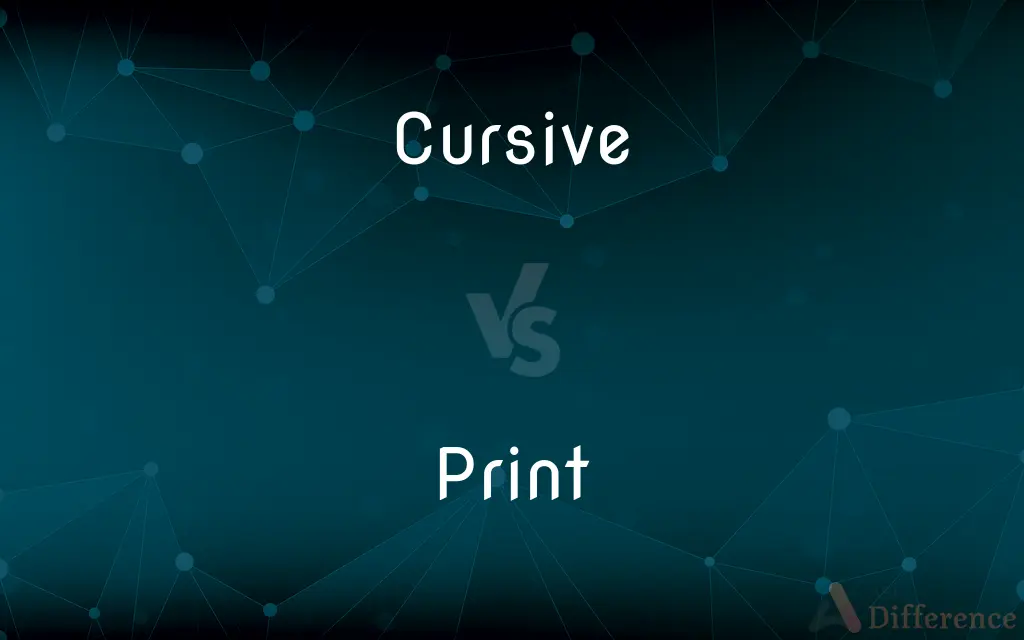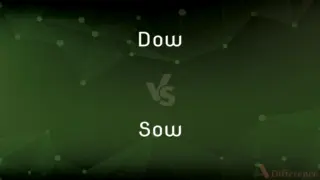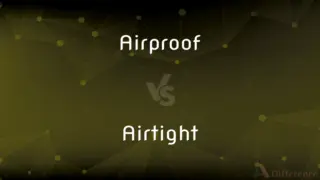Cursive vs. Print — What's the Difference?
By Tayyaba Rehman & Urooj Arif — Updated on April 2, 2024
Cursive writing is a style where letters are connected for faster, fluid writing, while print writing involves distinct, unconnected letters, enhancing readability.

Difference Between Cursive and Print
Table of Contents
ADVERTISEMENT
Key Differences
Cursive writing is characterized by flowing, connected letters, designed to facilitate faster handwriting. This style often requires fewer lifts of the pen or pencil, making it efficient for longer writing tasks. On the other hand, print writing, also known as block lettering, consists of distinct, unconnected letters. Print writing is typically taught first to children due to its simplicity and ease of recognition, laying the foundation for developing literacy skills.
The learning curve for cursive writing is generally steeper than for print due to the complexity of connecting letters and the variation in cursive styles. While mastering cursive can improve writing speed, print writing's clarity and straightforwardness make it the preferred choice for most printed materials, including books, signs, and documents.
Cursive writing can vary significantly between individuals, with personal styles often deviating from the standard taught in schools. This variation can sometimes impact readability, especially for those unfamiliar with a writer's particular style. Print writing, with its uniform appearance, tends to be more universally legible, contributing to its widespread use in formal communication.
Historically, cursive was favored for its efficiency and aesthetic appeal in handwritten documents. However, in the digital age, the prevalence of typing and text messaging has diminished the necessity and frequency of cursive writing. Conversely, print remains dominant in both handwritten and digital forms due to its readability and simplicity.
Educationally, the debate continues over the importance of teaching cursive in schools, with some arguing that it benefits fine motor skills and cognitive development, while others believe time would be better spent on developing digital literacy skills. Print writing, being fundamental to literacy, remains an essential part of early education curriculums.
ADVERTISEMENT
Comparison Chart
Letter Formation
Letters are connected, often with loops and joins.
Letters are separate and distinct, without connections.
Speed
Designed for speed through fewer pen lifts.
Generally slower due to pen lifts between letters.
Readability
Can vary greatly; often less legible to the untrained eye.
High; letters are clear and uniform, enhancing legibility.
Learning Curve
Steeper, due to the complexity of connections.
Simpler, making it easier for beginners to learn.
Use
Traditionally favored for handwritten letters and personal notes.
Dominant in printed materials and formal documents.
Compare with Definitions
Cursive
A method of writing designed for quick, efficient penmanship.
Old documents and letters were often written in cursive due to its speed.
A method of writing by which letters are drawn individually and not connected.
Elementary schools teach children to write in print before introducing cursive.
Cursive
Handwriting that connects letters with loops or lines.
His cursive was so elegant that it looked almost like calligraphy.
Writing that resembles the clear, distinct characters used in printed materials.
Her print handwriting is so neat, it almost looks typed.
Cursive
A style of penmanship where characters are written joined together in a flowing manner.
She practiced her cursive writing until her signature flowed beautifully.
A style of handwriting used for its clarity and ease of reading.
Official documents are typically filled out in print to avoid misunderstandings.
Cursive
The act or skill of writing in a connected, fluid script.
Cursive requires more fluid motion and muscle memory than print writing.
The act of writing letters and words without joining them together.
Even as an adult, he prefers print over cursive for its readability.
Cursive
A script in which the symbols of the language are written in a conjoined and/or flowing manner.
The Declaration of Independence is written in a cursive script.
The standard form of writing letters and words with clear separation between characters.
Print writing is essential for clear, legible signage.
Cursive
Cursive (also known as script, among other names) is any style of penmanship in which some characters are written joined together in a flowing manner, generally for the purpose of making writing faster, in contrast to block letters. Cursive handwriting is very functional, and is intended to be used in everyday writing.
Produce (books, newspapers, etc.), especially in large quantities, by a mechanical process involving the transfer of text or designs to paper
A thousand copies of the book were printed
Cursive
Having the successive letters joined together
Cursive writing.
A cursive style of type.
Write (text) clearly without joining the letters together
Print your name and address on the back of the cheque
Cursive
A cursive character or letter.
Mark (a surface, typically a fabric or garment) with a coloured design or pattern
A delicate fabric printed with roses
Cursive
A manuscript written in cursive characters.
The text appearing in a book, newspaper, or other printed publication, especially with reference to its size, form, or style
Bold print
She forced herself to concentrate on the tiny print
Cursive
(Printing) A type style that imitates handwriting.
An indentation or mark made on a surface or soft substance
There were paw prints everywhere
Cursive
Running; flowing.
A picture or design printed from a block or plate or copied from a painting by photography
The walls were hung with sporting prints
Cursive
(of writing) Having successive letters joined together.
A piece of fabric or clothing with a coloured pattern or design printed on it
Light summer prints
A floral print dress
Cursive
(grammar) Of or relating to a grammatical aspect relating to an action that occurs in a straight line (in space or time).
A mark or impression made in or on a surface by pressure
The print of footsteps in the sand.
Cursive
(countable) A cursive character, letter or font.
A fingerprint.
Cursive
(countable) A manuscript written in cursive characters.
A device or implement, such as a stamp, die, or seal, used to press markings onto or into a surface
Fancy letters made by hand-carved prints.
Cursive
(uncountable) Joined-up handwriting.
Something formed or marked by such a device.
Cursive
Running; flowing.
Text, lettering, or other marks produced in ink from type as by a printing press or from digital fonts by an electronic printer
Needed glasses to read the print.
Cursive
A character used in cursive writing.
Printed state or form
A short story that never got into print.
Cursive
A manuscript, especially of the New Testament, written in small, connected characters or in a running hand; - opposed to uncial.
A printed publication or edition of a text; a printing
The first print of that book has sold out.
Cursive
Rapid handwriting in which letters are set down in full and cursively connected within words without lifting the writing implement from the paper
A design or picture transferred from an engraved plate, wood block, lithographic stone, or other medium
Had prints of flowers hanging on the walls.
Cursive
Having successive letter joined together;
Cursive script
A photographic image transferred to paper or a similar surface.
A copy of a movie made on film or in a high resolution digital format, as for public exhibition.
A fabric or garment with a dyed pattern that has been pressed onto it, usually by engraved rollers.
The pattern itself
A blouse with a paisley print.
To press (a mark or design, for example) onto or into a surface
Tracks that were printed in the snow.
To make an impression on or in (a surface) with a device such as a stamp, seal, or die.
To press (something, such as a stamp) onto or into a surface to leave a marking.
To produce by means of pressed type, an electronic printer, or similar means, on a paper surface
Printed more copies of the ad.
To offer in printed form; publish
The publisher collected the essays and printed them as a book.
To reproduce (a digital document or image) on a paper surface
Printed the email.
To convert (a digital document) into a file format designed for publication.
To write (something) in characters similar to those commonly used in print.
To impress firmly in the mind or memory
An experience that will be printed in our hearts forever.
To produce a photographic image from (a negative, for example) by passing light through film onto a photosensitive surface, especially sensitized paper.
To produce (an electronic component) by mechanically transferring a circuit or circuit pattern onto a nonconductive surface.
To fabricate (an object) by means of a 3D printer.
To work as a printer.
To produce something in printed form by means of a printing press or other reproduction process.
To write characters similar to those commonly used in print.
To produce or receive an impression, marking, or image
The negative printed poorly.
Published or reproduced by printing, especially in contrast to electronic publication
A print newsletter.
Relating to or involved in media based on printing, especially newspapers and magazines
A print journalist.
Of, relating to, or writing for printed publications.
A print edition of a book
(transitive) To produce one or more copies of a text or image on a surface, especially by machine; often used with out or off: print out, print off.
Print the draft double-spaced so we can mark changes between the lines.
To produce a microchip (an integrated circuit) in a process resembling the printing of an image.
The circuitry is printed onto the semiconductor surface.
(ambitransitive) To write very clearly, especially, to write without connecting the letters as in cursive.
Print your name here and sign below.
I'm only in grade 2, so I only know how to print.
(ambitransitive) To publish in a book, newspaper, etc.
How could they print an unfounded rumour like that?
(transitive) To stamp or impress (something) with coloured figures or patterns.
To print calico
(transitive) To fix or impress, as a stamp, mark, character, idea, etc., into or upon something.
(transitive) To stamp something in or upon; to make an impression or mark upon by pressure, or as by pressure.
To display a string on the terminal.
To produce an observable value.
On March 16, 2020, the S&P printed at 2,386.13, one of the worst drops in history.
(transitive) To fingerprint (a person).
(uncountable) Books and other material created by printing presses, considered collectively or as a medium.
Three citations are required for each meaning, including one in print.
TV and the Internet haven't killed print.
(uncountable) Clear handwriting, especially, writing without connected letters as in cursive.
Write in print using block letters.
(uncountable) The letters forming the text of a document.
The print is too small for me to read.
(countable) A newspaper.
A visible impression on a surface.
Using a crayon, the girl made a print of the leaf under the page.
A fingerprint.
Did the police find any prints at the scene?
A footprint.
(visual art) A picture that was created in multiple copies by printing.
(photography) A photograph that has been printed onto paper from the negative.
(film) A copy of a film that can be projected.
Cloth that has had a pattern of dye printed onto it.
(architecture) A plaster cast in bas relief.
To fix or impress, as a stamp, mark, character, idea, etc., into or upon something.
A look will print a thought that never may remove.
Upon his breastplate he beholds a dint,Which in that field young Edward's sword did print.
Perhaps some footsteps printed in the clay.
To stamp something in or upon; to make an impression or mark upon by pressure, or as by pressure.
Forth on his fiery steed betimes he rode,That scarcely prints the turf on which he trod.
To strike off an impression or impressions of, from type, or from stereotype, electrotype, or engraved plates, or the like; in a wider sense, to do the typesetting, presswork, etc., of (a book or other publication); as, to print books, newspapers, pictures; to print an edition of a book.
To stamp or impress with colored figures or patterns; as, to print calico.
To take (a copy, a positive picture, etc.), from a negative, a transparent drawing, or the like, by the action of light upon a sensitized surface.
To use or practice the art of typography; to take impressions of letters, figures, or electrotypes, engraved plates, or the like.
To publish a book or an article.
From the moment he prints, he must except to hear no more truth.
A mark made by impression; a line, character, figure, or indentation, made by the pressure of one thing on another; as, the print of teeth or nails in flesh; the print of the foot in sand or snow.
Where print of human feet was never seen.
A stamp or die for molding or impressing an ornamental design upon an object; as, a butter print.
That which receives an impression, as from a stamp or mold; as, a print of butter.
Printed letters; the impression taken from type, as to excellence, form, size, etc.; as, small print; large print; this line is in print.
That which is produced by printing.
A core print. See under Core.
The result of the printing process;
I want to see it in black and white
A picture or design printed from an engraving
A visible indication made on a surface;
Some previous reader had covered the pages with dozens of marks
Paw prints were everywhere
A copy of a movie on film (especially a particular version of it)
A fabric with a dyed pattern pressed onto it (usually by engraved rollers)
A printed picture produced from a photographic negative
Put into print;
The newspaper published the news of the royal couple's divorce
These news should not be printed
Write as if with print; not cursive
Make into a print;
Print the negative
Reproduce by printing
Common Curiosities
Why is print writing considered more legible than cursive?
Print writing's distinct, unconnected letters make it clearer and easier to read for most people.
Do schools still teach cursive writing?
This varies by region and educational policy; some schools continue to teach cursive, while others have phased it out in favor of print and digital literacy.
Can adults learn cursive if they only know print writing?
Yes, adults can learn cursive with practice, similar to any other skill.
Why is print writing dominant in printed materials?
Print’s clarity and uniformity make it easier to read, especially for formal documents and instructional materials.
Are there any situations where cursive writing is preferred over print?
Cursive is sometimes preferred for its aesthetic appeal in personal notes, invitations, and artistic contexts.
Can learning cursive writing benefit children?
Proponents argue that cursive can improve fine motor skills and cognitive development, though its necessity is debated.
How has the digital age affected the use of cursive and print writing?
The rise of typing and digital communication has reduced the prevalence of cursive, while print remains widely used both digitally and in handwriting.
How does the readability of cursive and print writing impact their use in communication?
Print's legibility makes it preferred for formal communication, while cursive's personal touch is often reserved for informal settings.
Is print writing easier to learn for people learning English as a second language?
Yes, due to its clear and distinct letter forms, print writing is often easier for ESL learners.
What impact does learning print writing have on digital literacy?
Learning print provides a foundation for literacy that is essential for navigating digital platforms, which primarily use print-based text.
Is cursive writing faster than print writing?
Yes, cursive is designed to be faster due to fewer lifts of the pen or pencil.
Why might someone prefer using print over cursive, or vice versa?
Preferences often depend on the individual’s comfort, the task at hand, readability, and sometimes the aesthetic appeal of the handwriting style.
Is one style better than the other for learning to write?
Print is generally taught first due to its simplicity, but both styles have unique benefits. The choice depends on individual needs and educational goals.
How do handwriting styles like cursive and print affect note-taking?
Cursive can be faster for note-taking, though print might be preferred for its clarity when reviewing notes later.
Can the choice between cursive and print writing affect dyslexia?
Some research suggests that the distinct letters of print can be easier for individuals with dyslexia, though experiences vary.
Share Your Discovery

Previous Comparison
Dow vs. Sow
Next Comparison
Airproof vs. AirtightAuthor Spotlight
Written by
Tayyaba RehmanTayyaba Rehman is a distinguished writer, currently serving as a primary contributor to askdifference.com. As a researcher in semantics and etymology, Tayyaba's passion for the complexity of languages and their distinctions has found a perfect home on the platform. Tayyaba delves into the intricacies of language, distinguishing between commonly confused words and phrases, thereby providing clarity for readers worldwide.
Co-written by
Urooj ArifUrooj is a skilled content writer at Ask Difference, known for her exceptional ability to simplify complex topics into engaging and informative content. With a passion for research and a flair for clear, concise writing, she consistently delivers articles that resonate with our diverse audience.














































